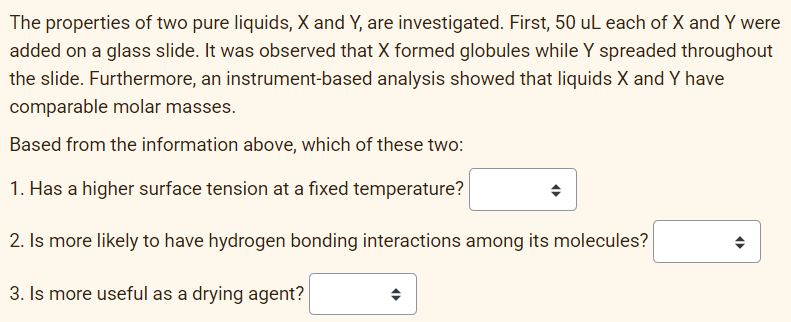The properties of two pure liquids, X and Y, are investigated. First, 50 uL each of X and Y were added on a glass slide. It was observed that X formed globules while Y spreaded throughout the slide. Furthermore, an instrument-based analysis showed that liquids X and Y have comparable molar masses. Based from the information above, which of these two: 1. Has a higher surface tension at a fixed temperature? 2. Is more likely to have hydrogen bonding interactions among its molecules? 3. Is more useful as a drying agent?
The properties of two pure liquids, X and Y, are investigated. First, 50 uL each of X and Y were added on a glass slide. It was observed that X formed globules while Y spreaded throughout the slide. Furthermore, an instrument-based analysis showed that liquids X and Y have comparable molar masses. Based from the information above, which of these two: 1. Has a higher surface tension at a fixed temperature? 2. Is more likely to have hydrogen bonding interactions among its molecules? 3. Is more useful as a drying agent?
Chapter10: Liquids And Solids
Section: Chapter Questions
Problem 1RQ: What are intermolecular forces? How do they differ from intramolecular forces? What are...
Related questions
Question

Transcribed Image Text:The properties of two pure liquids, X and Y, are investigated. First, 50 uL each of X and Y were
added on a glass slide. It was observed that X formed globules while Y spreaded throughout
the slide. Furthermore, an instrument-based analysis showed that liquids X and Y have
comparable molar masses.
Based from the information above, which of these two:
1. Has a higher surface tension at a fixed temperature?
2. Is more likely to have hydrogen bonding interactions among its molecules?
3. Is more useful as a drying agent?
Expert Solution
This question has been solved!
Explore an expertly crafted, step-by-step solution for a thorough understanding of key concepts.
Step by step
Solved in 2 steps

Knowledge Booster
Learn more about
Need a deep-dive on the concept behind this application? Look no further. Learn more about this topic, chemistry and related others by exploring similar questions and additional content below.Recommended textbooks for you


Chemistry: An Atoms First Approach
Chemistry
ISBN:
9781305079243
Author:
Steven S. Zumdahl, Susan A. Zumdahl
Publisher:
Cengage Learning

Chemistry
Chemistry
ISBN:
9781305957404
Author:
Steven S. Zumdahl, Susan A. Zumdahl, Donald J. DeCoste
Publisher:
Cengage Learning


Chemistry: An Atoms First Approach
Chemistry
ISBN:
9781305079243
Author:
Steven S. Zumdahl, Susan A. Zumdahl
Publisher:
Cengage Learning

Chemistry
Chemistry
ISBN:
9781305957404
Author:
Steven S. Zumdahl, Susan A. Zumdahl, Donald J. DeCoste
Publisher:
Cengage Learning

Introductory Chemistry: A Foundation
Chemistry
ISBN:
9781337399425
Author:
Steven S. Zumdahl, Donald J. DeCoste
Publisher:
Cengage Learning

Chemistry by OpenStax (2015-05-04)
Chemistry
ISBN:
9781938168390
Author:
Klaus Theopold, Richard H Langley, Paul Flowers, William R. Robinson, Mark Blaser
Publisher:
OpenStax

Chemistry & Chemical Reactivity
Chemistry
ISBN:
9781133949640
Author:
John C. Kotz, Paul M. Treichel, John Townsend, David Treichel
Publisher:
Cengage Learning